ผลของอุณหภูมิกลางวันและกลางคืนต่อการเจริญเติบโตและการออกดอกของปทุมมา
Main Article Content
บทคัดย่อ
การศึกษาผลของอุณหภูมิกลางวันกลางคืนต่อการเติบโตและการออกดอกของปทุมมา ดำเนินการที่มหาวิทยาลัยเชียงใหม่ในช่วยเดือนกุมภาพันธ์ถึงกรกฎาคม 2549 วางแผนการทดลองแบบสุมสมบูรณ์ ปลูกพืชไว้ในตู้ควบคุมที่ระดับอุณหภูมิกลางวัน/กลางคืน 4 ระดับ ได้แก่ 24/18, 30/18, 30/24 และ 36/24 องศาเซลเซยส โดยให้ทุกกรมมวิธีได้รับความเข้มแสง 270 µmol/m2/s ความชื้น 70-80% และความยาววัน 12 ชั่วโมงต่อวัน ผลการทดลองพบว่าต้นที่ปลูกในอุณหภูมิกลางวัน/กลางคืน 36/24 องศาเซลเซียส มีความสูง จำนวนใบต่อต้น พื้นที่ใบ จำนวนกลีบประดับสีชมพู ความยาวก้านดอก น้ำหนัแห้งใบ ราก และก้านดอก มากที่สุด พืชที่ปลูกในอุณหภูมิ 30/24 และ 36/24 องศาเซลเซียส มีความยาวใบเฉลี่ยมากที่สุด ส่วนพืชที่เจริญเติบโตในสภาพอุณหภูมิ 36/24 องศสเซลเซียส มีน้ำหนักแห้งของหัวและรากสะสมอาหารเฉลี่ยเหลือน้อยที่สุด นอกจากนี้ อุณหภูมิกลางวัน/กลางคืนที่แตกต่างกันไม่มีผลต่อความกว้างใบ จำนวนต้นต่อกอ ความเข้มของสีใบ ความกว้างและความยาวของช่อดอก จำนวนกลีบประดับสีเขียว และน้ำนักแห้งช่อดอก
Article Details
เอกสารอ้างอิง
เปรมปรี ณ สงขลา. 2546. รายงานการจัดงานอะเมซิ่งไม้ดอกเมืองร้อน. การมส่งเสริมการเกษตร, กรุงเทพฯ. 74 หน้า.
ลิลลี่ กาวีต๊ะ. 2546. การเปลี่ยนแปลงทางสันฐานและพัฒนาการของพืช. สำนักพิมพ์มหาวิทยาลัยเกษตรศาสตร์, กรุงเทพฯ. 320 หน้า
สุรวิช วรรณไกรโรจน์. 2539. ผลของคุณภาพและการเก็บรักษาหัวพันธุ์ต่อการผลิตปทุมมา. รายงานการประชุมทางวิชาการไม้ดอกไม้ประดับแห่งชาติ ครั้งที่ 2. สำนักงานคณะกรรมการวิจัยแห่งชาติ, กรุงเทพฯ. 247 หน้า.
Blackshaw, R.E. and T. Entz. 1995. Day and night temperature effects on vegetative growth of Erodium cicutarium. Weed Research 35: 471-476.
De Hertogh, A. and M, Le Nard. 1993. The Physiology of Flower Bulbs. Elsevier Science Publisher B.V., Amsterdam. 812 pp.
Hinesley, L.E. 1981. Initial growth of Fraser fir seedlings at different day/night temperatures. Forest Science 27: 545-550.
Ison, R.L. and L.R. Humphreys. 1984. Day and night temperature control of floral induction in Stylosanthes guianensis var. guianensis cv. Schofield. Annals of Botany 53: 207-212.
Kamenetsky, R., H. Zemah, A. van der Toorn, H.D. Rabinowitch, H. van As and P. Bendel. 2000. Morphological structure and water status in tulip bulbs during their transition from dormancy to active growth: visualization by NMR imaging. pp. 121-138. In: J.D. Viemont and J. Crabbe (eds.). Dormancy in Plants: From Whole Plant Behaviour to Cellular Contrl. CABI Publishing, Wallingford.
Mouradov, A., F. Cremer and G. Coupland. 2002. Control of flowering time: Interacting pathways as a basis for diversity. Plant Cell 14: 111-130.
Rees, A.R. 1992. Ornamental bulbs, Corms and Tubers. CABI Publishing, Wallingford. 220 pp.
Smith, D.R. and R.W. Langhans. 1961. The influence of day and night temperatures on the growth and flowering of the Easter lily (Lilium longiflorum Thumb. var. Croft). J. Amer. Soc. Hort. Sci. 80: 593-598.
Steer, B.T. 1981. The effect of growth and temperature on dry weight and carbohydrate content of onion (Allium cepa L. cv. Creamgold) bulbs. Australian Journal of Agricultural Research 33(3): 559-563.
Tageras, H. 1979. Modifying effects of ancymidol and gibberellins on temperature induced elongation in Fuchsia x hybrida. Acta Hort. 91: 411-417.
Thingnaes, E., S. Torre, A. Ernstsen and R. Moe. 2003. Day and night temperature responses in Arabidopsis: effect on gibberellin and auxin content, cell size, morphology and flowering time. Annals of Botany 92(4): 601-612.
Van der Zanden, A.M. 2008. Environmental factors affecting growth. (Online). Available: http://extension.oregonstate.edu/mg/botany/env_factors.html (May 20, 2008).


